#lesbian big mac
Photo

Her <3
4K notes
·
View notes
Text
Okay, let's make something crystal clear.
Her? She is NOT a butch dyke! She is a tomboy!

THIS is what a real butch dyke looks like!!!

#my little pony#mlp#rainbow dash#big mac#lesbian#dyke#butch#tomboy#transgender#not art#shitpost#also don't get me wrong RD is still a massive dyke#just not a butch dyke
498 notes
·
View notes
Text
song lyric collages!
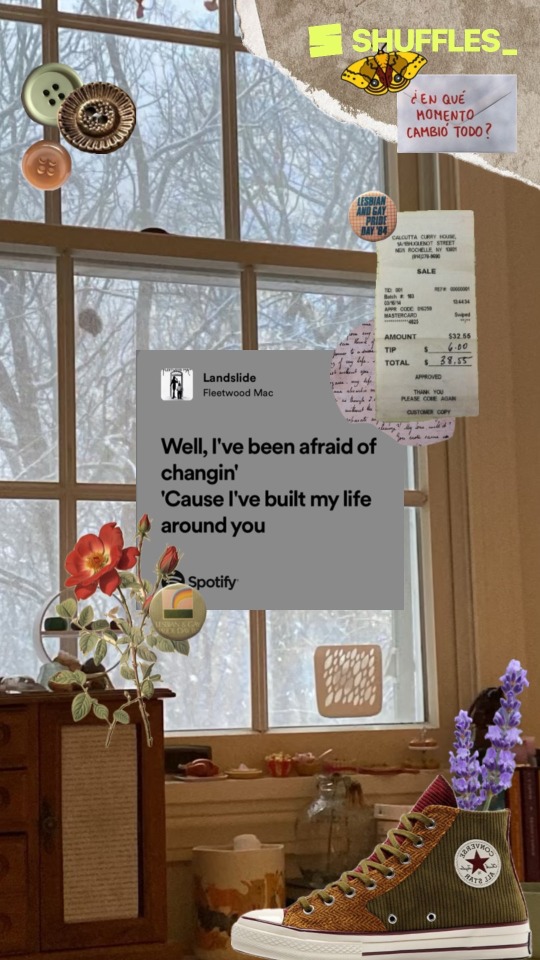



#adrienne lenker#lesbian#big theif#collage#phoebe bridgers#lucy dacus#julien baker#crystal#spring#boygenius#fleetwood mac#queer artwork#hashtag
17 notes
·
View notes
Text

Some fluffy ApplePie 🍎🥧🎀🎁
#my little pony#mlp#mlp g4#friendship is magic#applepie#pinkie pie#applejack#they���re drawn in those colours cause I used the lesbian and pan pride flag colours#applejack is a lesbian and pinkie is pan :3#digital art#my art#clip studio paint#artists on tumblr#fanart#also I do not consider this ship in///cest please don’t accuse me of such#the show itself has an ep with Big Mac and Marble Pie blushing at each other and liking each other so
45 notes
·
View notes
Text
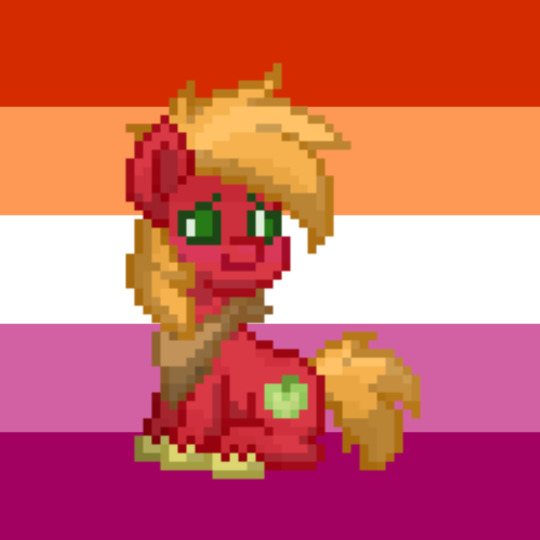

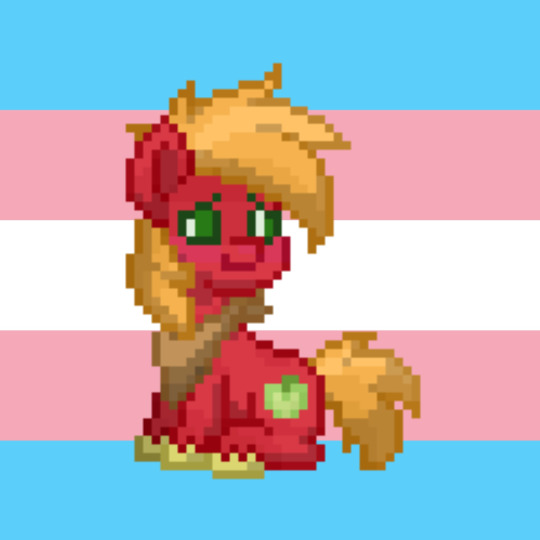
Big Mac is a Trans Lesbian!
*free to use with credit*
#pony town#pride ponies#mlp#my little pony#mlp fim#mlp g4#big mac#big macintosh#big mcintosh#lesbian#homosexual#homoromantic#transgender
42 notes
·
View notes
Text
pspspsps imma drop my mlp queer headcanons
twilight: aroace or ace and bi (cause of the mane mostly lol) but i like aroace twili more
rainbow: raging lesbian obviously, but also gives me enby vibes, they/them pronouns
aj: also raging lesbian <3
rarity: lesbian with rly bad comphet, thought she was bi for a while but realized she actually doesn't like men
pinkie: also aroace i think, genderqueer in some way, any pronouns and rly likes neos
fluttershy: pan and transfemme, she/they
starlight: bi and a demigirl, they/she
trixie: trans lesbian, she/her
maude: ace
big mac: trans lesbian and also ace
some additional stuff:
- rd and aj are platonic soulmates, they really are butch besties for life
- rd helped rarijack get together
- aj was closeted untill her mid-twenties, but she knew she was a lesbian since like forever
- also aj was the first person big mac came out as trans to, not long after aj came out herself, cause she felt she could trust her with this
- trixie definitly helped realize starlight they are not-cis in some way lol
- twili is the type of aroace that loves romance in books but irl just,, nope
#my little pony#twilight sparkle#apple jack#rainbow dash#pinkie pie#rarity#fluttershy#starlight glimmer#trixie lulamoon#maude pie#big mac#aromantic#asexual#lesbian#bisexual#pansexual#nonbinary#transgender#genderqueer#transfemme#demigirl#queer
20 notes
·
View notes
Text



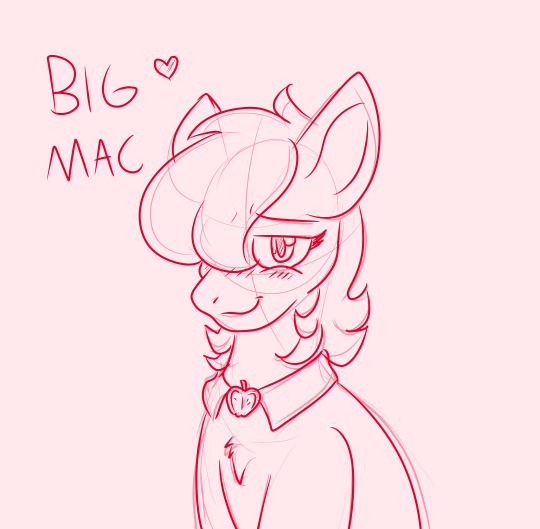

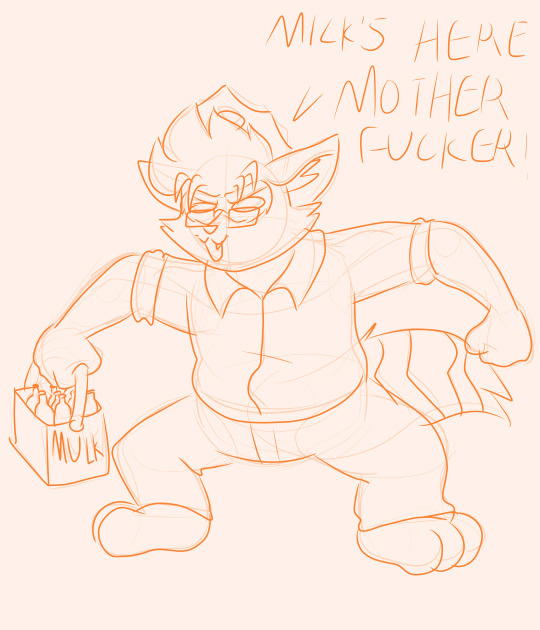
#art#sketch#artist#furry#anthro#cute#digital art#fan art#fur#slarpg#super lesbian animal rpg#big mac#mlp#trans femme big mac#ramona flowers#wolf#god fucking damn it kris
22 notes
·
View notes
Text
to celebrate international womens day i have decided to turn all my ships into yuri‼️‼️‼️‼️
#neal nocturne is a twinky hesbian and him and carm meet when he gets his carabiner stuck on her fishnets#stewy helps kendall when shes first starting e for the first time in her life early 40s and stewys been bigender doll the whole time#hannigram self explanatory i think#macden mac is just the strongest stupidest butch uve ever seen in ur life and dennis lightbulb realises shes a woman#all the other yaoi im forgetting got woman beamed also#and shoutout to all my already lesbian ships i hold so dear to me#also everyone go watch bottoms 2023#also both seasons of hacks toxic yuri is coming back in a big way very soon#society if i just made all my post in my post instead of in the tags like a fucking twitter user#i really fell down a rabbit hole here#anyway#mrrow
6 notes
·
View notes
Text
I have written my first ever fanfic and it's essentially a story to explain my headcanon that explains the weirdness in the Equestria Girls timeline
#mlp#equestria girls#my art#i have another fic already written about applejack figuring out hes a he/him lesbian and one in progress about big mac getting so very high
11 notes
·
View notes
Text
mcdonalds is on twitter like "hmm i want a big mac rn... anyone else?" and some people honestly believe that amtrak is on tumblr talking about lesbian sex and hating train cops
2K notes
·
View notes
Text
In 2006, the year Taylor Swift released her first single, a closeted country singer named Chely Wright, then 35, held a 9-millimeter pistol to her mouth. Queer identity was still taboo enough in mainstream America that speaking about her love for another woman would have spelled the end of a country music career. But in suppressing her identity, Ms. Wright had risked her life.
In 2010, she came out to the public, releasing a confessional memoir, “Like Me,” in which she wrote that country music was characterized by culturally enforced closeting, where queer stars would be seen as unworthy of investment unless they lied about their lives. “Country music,” she wrote, “is like the military — don’t ask, don’t tell.”
The culture in which Ms. Wright picked up that gun — the same one in which Ms. Swift first became a star — was stunningly different from today’s. It’s dizzying to think about the strides that have been made in Americans’ acceptance of the L.G.B.T.Q. community over the past decade: marriage equality, queer themes dominating teen entertainment, anti-discrimination laws in housing and, for now, in the workplace. But in recent years, a steady drip of now-out stars — Cara Delevingne, Colton Haynes, Elliot Page, Kristen Stewart, Raven-Symoné and Sam Smith among them — have disclosed that they had been encouraged to suppress their queerness in order to market projects or remain bankable.
The culture of country music hasn’t changed so much that homophobia is gone. Just this past summer, Adam Mac, an openly gay country artist, was shamed out of playing at a festival in his hometown because of his sexual orientation. In September, the singer Maren Morris stepped away from country music; she said she did so in part because of the industry’s lingering anti-queerness. If country music hasn’t changed enough, what’s to say that the larger entertainment industry — and, by extension, our broader culture — has?
Periodically, I return to a video, recorded by a shaky hand more than a decade ago, of Ms. Wright answering questions at a Borders bookstore about her coming out. She likens closeted stardom to a blender, an “insane” and “inhumane” heteronormative machine in which queer artists are chewed to bits.
“It’s going to keep going,” Ms. Wright says, “until someone who has something to lose stands up and just says ‘I’m gay.’ Somebody big.” She continues: “We need our heroes.”
What if someone had already tried, at least once, to change the culture by becoming such a hero? What if, because our culture had yet to come to terms with homophobia, it wasn’t ready for her?
What if that hero’s name was Taylor Alison Swift?
In the world of Taylor Swift, the start of a new “era” means the release of new art (an album and the paratexts — music videos, promotional ephemera, narratives — that supplement it) and a wholesale remaking of the aesthetics that will accompany its promotion, release and memorializing. In recent years, Ms. Swift has dominated pop culture to such a degree that these transformations often end up altering American culture in the process.
In 2019, she was set to release a new album, “Lover,” the first since she left Big Machine Records, her old Nashville-based label, which she has since said limited her creative freedom. The aesthetic of what would be known as the “Lover Era” emerged as rainbows, butterflies and pastel shades of blue, purple and pink, colors that subtly evoke the bisexual pride flag.
On April 26, Lesbian Visibility Day, Ms. Swift released the album’s lead single, “ME!,” in which she sings about self-love and self-acceptance. She co-directed a campy music video to accompany it, which she would later describe as depicting “everything that makes me, me.” It features Ms. Swift dancing at a pride parade, dripping in rainbow paint and turning down a man’s marriage proposal in exchange for a … pussy cat.
At the end of June, the L.G.B.T.Q. community would celebrate the 50th anniversary of the Stonewall Riots. On June 14, Ms. Swift released the video for her attempt at a pride anthem, “You Need to Calm Down,” in which she and an army of queer celebrities from across generations — the “Queer Eye” hosts, Ellen DeGeneres, Billy Porter, Hayley Kiyoko, to name a few — resist homophobia by living openly. Ms. Swift sings that outrage against queer visibility is a waste of time and energy: “Why are you mad, when you could be GLAAD?”
The video ends with a plea: “Let’s show our pride by demanding that, on a national level, our laws truly treat all of our citizens equally.” Many, in the press and otherwise, saw the video as, at best, a misguided attempt at allyship and, at worst, a straight woman co-opting queer aesthetics and narratives to promote a commercial product.
Then, Ms. Swift performed “Shake It Off” as a surprise for patrons at the Stonewall Inn. Rumors — that were, perhaps, little more than fantasies — swirled in the queerer corners of her fandom, stoked by a suggestive post by the fashion designer Christian Siriano. Would Ms. Swift attend New York City’s WorldPride march on June 30? Would she wear a dress spun from a rainbow? Would she give a speech? If she did, what would she declare about herself?
The Sunday of the march, those fantasies stopped. She announced that the music executive Scooter Braun, who she described as an “incessant, manipulative” bully, had purchased her masters, the lucrative original recordings of her work.
Ms. Swift’s “Lover” was the first record that she created with nearly unchecked creative freedom. Lacking her old label’s constraints, she specifically chose to feature activism for and the aesthetics of the L.G.B.T.Q. community in her confessional, self-expressive art. Even before the sale of her masters, she appeared to be stepping into a new identity — not just an aesthetic — that was distinct from that associated with her past six albums.
When looking back on the artifacts of the months before that album’s release, any close reader of Ms. Swift has a choice. We can consider the album’s aesthetics and activism as performative allyship, as they were largely considered to be at the time. Or we can ask a question, knowing full well that we may never learn the answer: What if the “Lover Era” was merely Ms. Swift’s attempt to douse her work — and herself — in rainbows, as so many baby queers feel compelled to do as they come out to the world?
There’s no way of knowing what could have happened if Ms. Swift’s masters hadn’t been sold. All we know is what happened next. In early August, Ms. Swift posted a rainbow-glazed photo of a series of friendship bracelets, one of which says “PROUD” with beads in the color of the bisexual pride flag. Queer people recognize that this word, deployed this way, typically means that someone is proud of their own identity. But the public did not widely view this as Ms. Swift’s coming out.
Then, Vogue released an interview with Ms. Swift that had been conducted in early June. When discussing her motivations for releasing “You Need to Calm Down,” Ms. Swift said, “Rights are being stripped from basically everyone who isn’t a straight white cisgender male.” She continued: “I didn’t realize until recently that I could advocate for a community that I’m not a part of.” That statement suggests that Ms. Swift did not, in early June, consider herself part of the L.G.B.T.Q. community; it does not illuminate whether that is because she was a straight, cis ally or because she was stuck in the shadowy, solitary recesses of the closet.
On Aug. 22, Ms. Swift publicly committed herself to the as-of-then-unproven project of rerecording and rereleasing her first six albums. The next day, she finally released “Lover,” which raises more questions than it answers. Why does she have to keep secrets just to keep her muse, as all her fans still sing-scream on “Cruel Summer”? About what are the “hundred thrown-out speeches I almost said to you,” in her chronicle of self-doubt, “The Archer,” if not her identity? And what could the album’s closing words, which come at the conclusion of “Daylight,” a song about stepping out of a 20-year darkness and choosing to “let it go,” possibly signal?
I want to be defined by the things that I love,
Not the things I hate,
Not the things that I’m afraid of, I’m afraid of,
Not the things that haunt me in the middle of the night,
I just think that,
You are what you love.
The first time I viewed “Lover” through the prism of queerness, I felt delirious, almost insane. I kept wondering whether what I was perceiving in her work was truly there or if it was merely a mirage, born of earnest projection.
My longtime reading of Ms. Swift’s celebrity — like that of a majority of her fan base — had been stuck in the lingering assumptions left by a period that began more than a decade and a half ago, when a girl with an overexaggerated twang, Shirley Temple curls and Georgia stars in her eyes became famous. Then, she presented as all that was to be expected of a young starlet: attractive yet virginal, knowing yet naïve, not talented enough to be formidable, not commanding enough to be threatening, confessional, eager to please. Her songs earnestly depicted the fantasies of a girl raised in a traditional culture: high school crushes and backwoods drives, princelings and wedding rings, declarations of love that climax only in a kiss — ideally in the pouring rain.
When Ms. Swift was trying to sell albums in that late-2000s media environment, her songwriting didn’t match the image of a sex object, the usual role reserved for female celebrities in our culture. Instead, the story the public told about her was that she laundered her affection to a litter of promising grown men, in exchange for songwriting inspiration. A young Ms. Swift contributed to this narrative by hiding easy-to-decode clues in liner notes that suggested a certain someone was her songs’ inspiration (“SAM SAM SAM SAM SAM SAM,” “ADAM,” “TAY”) or calling out an ex-boyfriend on the “Ellen” show and “Saturday Night Live.” Despite the expansive storytelling in Ms. Swift’s early records, her public image often cast a man’s interest as her greatest ambition.
As Ms. Swift’s career progressed, she began to remake that image: changing her style and presentation, leaving country music for pop and moving from Nashville to New York. By 2019, her celebrity no longer reflected traditional culture; it had instead become a girlboss-y mirror for another dominant culture — that of white, cosmopolitan, neoliberal America.
But in every incarnation, the public has largely seen those songs — especially those for which she doesn’t directly state her inspiration — as cantos about her most recent heterosexual love, whether that idea is substantiated by evidence or not. A large portion of her base still relishes debating what might have happened with the gentleman caller who supposedly inspired her latest album. Feverish discussions of her escapades with the latest yassified London Boy or mustachioed Mr. Americana fuel the tabloid press — and, embarrassingly, much of traditional media — that courts fan engagement by relentlessly, unquestioningly chronicling Ms. Swift’s love life.
Even in 2023, public discussion about the romantic entanglements of Ms. Swift, 34, presumes that the right man will “finally” mean the end of her persistent husbandlessness and childlessness. Whatever you make of Ms. Swift’s extracurricular activities involving a certain football star (romance for the ages? strategic brand partnership? performance art for entertainment’s sake?), the public’s obsession with the relationship has been attention-grabbing, if not lucrative, for all parties, while reinforcing a story that America has long loved to tell about Ms. Swift, and by extension, itself.
Because Ms. Swift hasn’t undeniably subverted our culture’s traditional expectations, she has managed, in an increasingly fractured cultural environment, to simultaneously capture two dominant cultures — traditional and cosmopolitan. To maintain the stranglehold she has on pop culture, Ms. Swift must continue to tell a story that those audiences expect to consume; she falls in love with a man or she gets revenge. As a result, her confessional songs languish in a place of presumed stasis; even as their meaning has grown deeper and their craft more intricate, a substantial portion of her audience’s understanding of them remains wedded to the same old narratives.
But if interpretations of Ms. Swift’s art often languish in stasis, so do the millions upon millions of people who love to play with the dollhouse she has constructed for them. Her dominance in pop culture and the success of her business have given her the rare ability to influence not only her industry but also the worldview of a substantial portion of America. How might her industry, our culture and we, ourselves, change if we made space for Ms. Swift to burn that dollhouse to the ground?
Anyone considering the whole of Ms. Swift’s artistry — the way that her brilliantly calculated celebrity mixes with her soul-baring art — can find discrepancies between the story that underpins her celebrity and the one captured by her songs. One such gap can be found in her “Lover” era. Others appear alongside “dropped hairpins,” or the covert ways someone can signal queer identity to those in the know while leaving others comfortable in their ignorance. Ms. Swift dropped hairpins before “Lover” and has continued to do so since.
Sometimes, Ms. Swift communicates through explicit sartorial choices — hair the colors of the bisexual pride flag or a recurring motif of rainbow dresses. She frequently depicts herself as trapped in glass closets or, well, in regular closets. She drops hairpins on tour as well, paying tribute to the Serpentine Dance of the lesbian artist Loie Fuller during the Reputation Tour or referencing “The Ladder,” one of the earliest lesbian publications in the United States, in her Eras Tour visuals.
During the Eras Tour, Ms. Swift traps her past selves — including those from her “Lover” era — in glass closets.
Dropped hairpins also appear in Ms. Swift’s songwriting. Sometimes, the description of a muse — the subject of her song, or to whom she sings — seems to fit only a woman, as it does in “It’s Nice to Have a Friend,” “Maroon” or “Hits Different.” Sometimes she suggests a female muse through unfulfilled rhyme schemes, as she does in “The Very First Night,” when she sings “didn’t read the note on the Polaroid picture / they don’t know how much I miss you” (“her,” instead of that pesky little “you,” would rhyme). Her songwriting also noticeably alludes to poets whose muses the historical record incorrectly cast as men — Emily Dickinson chief among them — as if to suggest the same fate awaits her art. Stunningly, she even explicitly refers to dropping hairpins, not once, but twice, on two separate albums.
In isolation, a single dropped hairpin is perhaps meaningless or accidental, but considered together, they’re the unfurling of a ballerina bun after a long performance. Those dropped hairpins began to appear in Ms. Swift’s artistry long before queer identity was undeniably marketable to mainstream America. They suggest to queer people that she is one of us. They also suggest that her art may be far more complex than the eclipsing nature of her celebrity may allow, even now.
Since at least her “Lover” era, Ms. Swift has explicitly encouraged her fans to read into the coded messages (which she calls “Easter eggs”) she leaves in music videos, social media posts and interviews with traditional media outlets, but a majority of those fans largely ignore or discount the dropped hairpins that might hint at queer identity. For them, acknowledging even the possibility that Ms. Swift could be queer would irrevocably alter the way they connect with her celebrity, the true product they’re consuming.
There is such public devotion to the traditional narrative Ms. Swift embodies because American culture enshrines male power. In her sweeping essay, “Compulsory Heterosexuality and Lesbian Existence,” the lesbian feminist poet Adrienne Rich identified the way that male power cramps, hinders or devalues women’s creativity. All of the sexist undertones with which Ms. Swift’s work can be discussed (often, even, by fans) flow from compulsory heterosexuality, or the way patriarchy draws power from the presumption that women naturally desire men. She must write about men she surely loves or be unbankable; she must marry and bear children or remain a child herself; she must look like, in her words, a “sexy baby” or be undesirable, “a monster on the hill.”
A woman who loves women is most certainly a monster to a society that prizes male power. She can fulfill none of the functions that a traditional culture imagines — wife, mother, maid, mistress, whore — so she has few places in the historical record. The Sapphic possibility of her work is ignored, censored or lost to time. If there is queerness earnestly implied in Ms. Swift’s work, then it’s no wonder that it, like that of so many other artists before her, is so often rendered invisible in the public imagination.
While Ms. Swift’s songs, largely written from her own perspective, cannot always conform to the idea of a woman our culture expects, her celebrity can. That separation, between Swift the songwriter and Swift the star, allows Ms. Swift to press against the golden birdcage in which she has found herself. She can write about women’s complexity in her confessional songs, but if ever she chooses not to publicly comply with the dominant culture’s fantasy, she will remain uncategorizable, and therefore, unsellable.
Her star — as bright as it is now — would surely dim.
Whether she is conscious of it or not, Ms. Swift signals to queer people — in the language we use to communicate with one another — that she has some affinity for queer identity. There are some queer people who would say that through this sort of signaling, she has already come out, at least to us. But what about coming out in a language the rest of the public will understand?
The difference between any person coming out and a celebrity doing so is the difference between a toy mallet and a sledgehammer. It’s reasonable for celebrities to be reticent; by coming out, they potentially invite death threats, a dogged tabloid press that will track their lovers instead of their beards, the excavation of their past lives, a torrent of public criticism and the implosion of their careers. In a culture of compulsory heterosexuality, to stop lying — by omission or otherwise — is to risk everything.
American culture still expects that stars are cis and straight until they confess themselves guilty. So, when our culture imagines a celebrity’s coming out, it expects an Ellen-style announcement that will submerge the past life in phoenix fire and rebirth the celebrity in a new image. In an ideal culture, wearing a bracelet that says “PROUD,” waving a pride flag onstage, placing a rainbow in album artwork or suggestively answering fan questions on Instagram would be enough. But our current reality expects a supernova.
Because of that expectation, stars end up trapped behind glass, which is reinforced by the tabloid press’s subtle social control. That press shapes the public’s expectations of others’ identities, even when those identities are chasms away from reality. Celebrities who master this press environment — Ms. Swift included — can bolster their business, but in doing so, they reinforce a heteronormative culture that obsesses over pregnancy, women’s bodies and their relationships with men.
That environment is at odds with the American movement for L.G.B.T.Q. equality, which still has fights to win — most pressingly, enshrining trans rights and squashing nonsensical culture wars. But lately I’ve heard many of my young queer contemporaries — and the occasional star — wonder whether the movement has come far enough to dispense with the often messy, often uncomfortable process of coming out, over and over again.
That questioning speaks to an earnest conundrum that queer people confront regularly: Do we live in this world, or the world to which we ought to aspire?
Living in aspiration means ignoring the convention of coming out in favor of just … existing. This is easier for those who can pass as cis and straight if need be, those who are so wealthy or white that the burden of hiding falls to others and those who live in accepting urban enclaves. This is a queer life without friction; coming out in a way straight people can see is no longer a prerequisite for acceptance, fulfillment and equality.
This aspiration is tremendous, but in our current culture, it is available only to a privileged few. Should such an inequality of access to aspiration become the accepted state of affairs, it would leave those who can’t hide to face society’s cruelest actors without the backing of a vocal, activated community. So every queer person who takes issue with the idea that we must come out ought to ask a simple question — what do we owe one another?
If coming out is primarily supposed to be an act of self-actualization, to form our own identities, then we owe one another nothing. This posture recognizes that the act of coming out implicitly reinforces straight and cis identities as default, which is not worth the rewards of outness.
But if coming out is supposed to be a radical act of resistance that seeks to change the way our society imagines people to be, then undeniable visibility is essential to make space for those without power. In this posture, queer people who can live in aspiration owe those who cannot a real world in which our expansive views of love and gender aren’t merely tolerated but celebrated. We have no choice but to actively, vocally press against the world we’re in, until no one is stuck in it.
And so just for a little while longer, we need our heroes.
But if queer people spend all of our time holding out for a guiding light, we might forgo a more pressing question that if answered, just might inch all of us a bit closer to aspiration. The next time heroes appear, are we ready to receive them?
It takes neither a genius nor a radical to see queerness implied by Ms. Swift’s work. But figuring out how to talk about it before the star labels herself is another matter. Right now, those who do so must inject our perceptions with caveats and doubt or pretend we cannot see it (a lie!) — implicitly acquiescing to convention’s constraints in the name of solidarity.
Lying is familiar to queer people; we teach ourselves to do it from an early age, shrouding our identities from others, and ourselves. It’s not without good reason. To maintain the safety (and sometimes the comfort) of the closet, we lie to others, and, most crucially, we allow others to believe lies about us, seeing us as something other than ourselves. Lying is doubly familiar to those of us who are women. To reduce friction, so many of us still shrink life to its barest version in the name of honor or safety, rendering our lives incomplete, our minds lobotomized and our identities unexplored.
By maintaining a culture of lying about what we, uniquely, have the knowledge and experience to see, we commit ourselves to a vow of silence. That vow may protect someone’s safety, but when it is applied to works of culture, it stymies our ability to receive art that has the potential to change or disrupt us. As those with queer identity amass the power of commonplaceness, it’s worth questioning whether the purpose of one of the last great taboos that constrains us befits its cost.
In every case, is the best form of solidarity still silence?
I know that discussing the potential of a star’s queerness before a formal declaration of identity feels, to some, too salacious and gossip-fueled to be worthy of discussion. They might point to the viciousness of the discourse around “queerbaiting” (in which I have participated); to the harm caused by the tabloid press’s dalliances with outing; and, most crucially, to the real material sacrifices that queer stars make to come out, again and again, as reasons to stay silent.
I share many of these reservations. But the stories that dominate our collective imagination shape what our culture permits artists and their audiences to say and be. Every time an artist signals queerness and that transmission falls on deaf ears, that signal dies. Recognizing the possibility of queerness — while being conscious of the difference between possibility and certainty — keeps that signal alive.
So, whatever you make of Ms. Swift’s sexual orientation or gender identity (something that is knowable, perhaps, only to her) or the exact identity of her muses (something better left a mystery), choosing to acknowledge the Sapphic possibility of her work has the potential to cut an audience that is too often constrained by history, expectation and capital loose from the burdens of our culture.
To start, consider what Ms. Swift wrote in the liner notes of her 2017 album, “reputation”: “When this album comes out, gossip blogs will scour the lyrics for the men they can attribute to each song, as if the inspiration for music is as simple and basic as a paternity test.”
Listen to her. At the very least, resist the urge to assume that when Ms. Swift calls the object of her affection “you” in a song, she’s talking about a man with whom she’s been photographed. Just that simple choice opens up a world of Swiftian wordplay. She often plays with pronouns, trading “you” and “him” so that only someone looking for a distinction between two characters might find one. Turns of phrase often contain double or even triple meanings. Her work is a feast laid specifically for the close listener.
Choosing to read closely can also train the mind to resist the image of an unmarried woman that compulsory heterosexuality expects. And even if it is only her audience who points at rainbows, reading Ms. Swift’s work as queer is still worthwhile, for it undermines the assumption that queer identity impedes pop superstardom, paving the way for an out artist to have the success Ms. Swift has.
After all, would it truly be better to wait to talk about any of this for 50, 60, 70 years, until Ms. Swift whispers her life story to a biographer? Or for a century or more, when Ms. Swift’s grandniece donates her diaries to some academic library, for scholars to pore over? To ensure that mea culpas come only when Ms. Swift’s bones have turned to dust and fragments of her songs float away on memory’s summer breeze?
I think not. And so, I must say, as loudly as I can, “I can see you,” even if I risk foolishness for doing so.
I remember the first time I knew I had seen Taylor Alison Swift break free from the trap of stardom. I wasn’t sitting in a crowded stadium in the pouring rain or cuddled up in a movie theater with a bag of popcorn. I was watching a grainy, crackling livestream of the Eras Tour, captured on a fan’s phone.
It’s late at night, the beginning of her acoustic set of surprise songs, this time performed in a yellow dress. She begins playing “Hits Different.” It’s a new song, full of puns, double entendres and wordplay, that toys with the glittering identities in which Ms. Swift indulges.
She’s rushing, as if stopping, even for a second, will cause her to lose her nerve. She stumbles at the bridge, pauses and starts again; the queen of bridges will not mess this up, not tonight.
There it is, at the bridge’s end: “Bet I could still melt your world; argumentative, antithetical dream girl.” An undeniable declaration of love to a woman. As soon as those words leave her lips, she lets out a whoop, pacing around the stage with a grin that cannot be contained.
For a moment, Ms. Swift was out of the woods she had created for herself as a teenager, floating above the trees. The future was within reach; she would, and will, soon take back the rest of her words, her reputation, her name. Maybe the world would see her, maybe it wouldn’t.
But on that stage, she found herself. I was there. Through a fuzzy fancam, I saw it.
And somehow, that was everything.
#ooooh my word this was BREATHTAKING and so well-said#because coming out is in fact a very delicate thing#full article here for the tumblr crowd!#taylor swift#articles#new york times#gaylor swift#gaylor#lover#chely wright
228 notes
·
View notes
Text
mlp x rdr au (autistically)

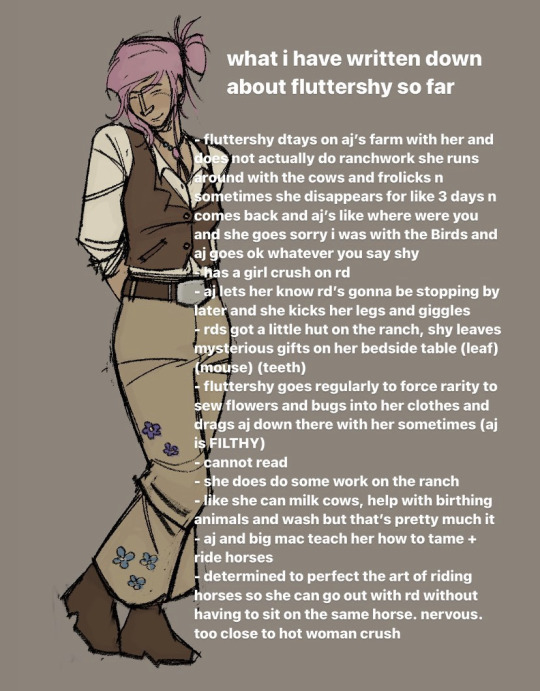
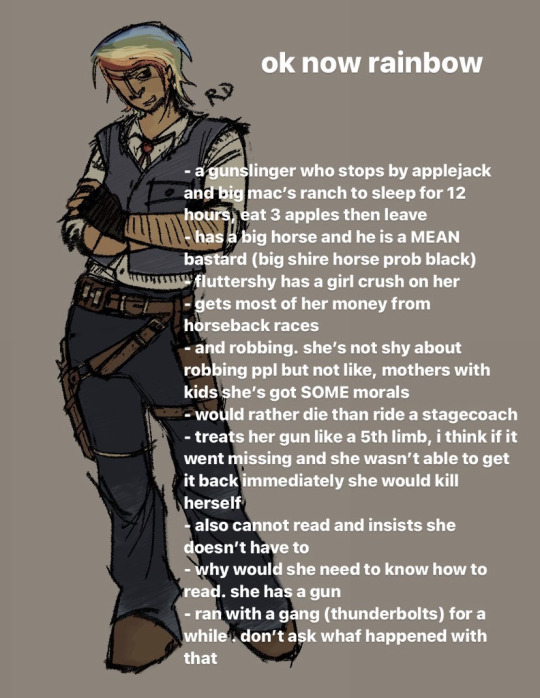


my little pony x red dead redemption au bc i am CRAZY!!!! except the only ones i haven’t finished designing is pinkie and twilight
set in the late 1800s (not accurate i get my information from one thing and one thing only) (red dead redemption), aj and big mac’s farm is heavily inspired by the macfarlane farm in rdr1, fluttershy and rd’s designs are also heavily inspired by bonnie’s design and john’s default outfit
i sort of completely made some shit up for rarity’s parents cuz i’m pretty sure all that’s known about them are their names 💥💥🦅🦅🇺🇸🇺🇸🇺🇸🇺🇸
rundown: (????or whatever idk
shy - trans pansexual woman, 26, 5’9
rd - cis queer woman, 27(2 years old❤️), 5’5
aj - cis lesbian woman, 29, 5’8
rarity - cis bisexual asexual woman, 30, 5’7
twi - cis bisexual woman, 28, 5’7
pinkie - cis pansexual woman, 26, 5’4
pondering twilight and pinkie’s occupation before i’m set on a design. twilight maybe a librarian and pinkie a rodeo star (buffalo bill cody type beat) 🦅🦅🇺🇸🇺🇸🇺🇸🇺🇸🇺🇸‼️‼️‼️
fluttershy and aj and pinkie are all cousins, pinkie is like a more distant cousin while shy and aj are like 2nd cousins (does that make sense i don’t actaully know how cousin closeness works but it makes sense in my head
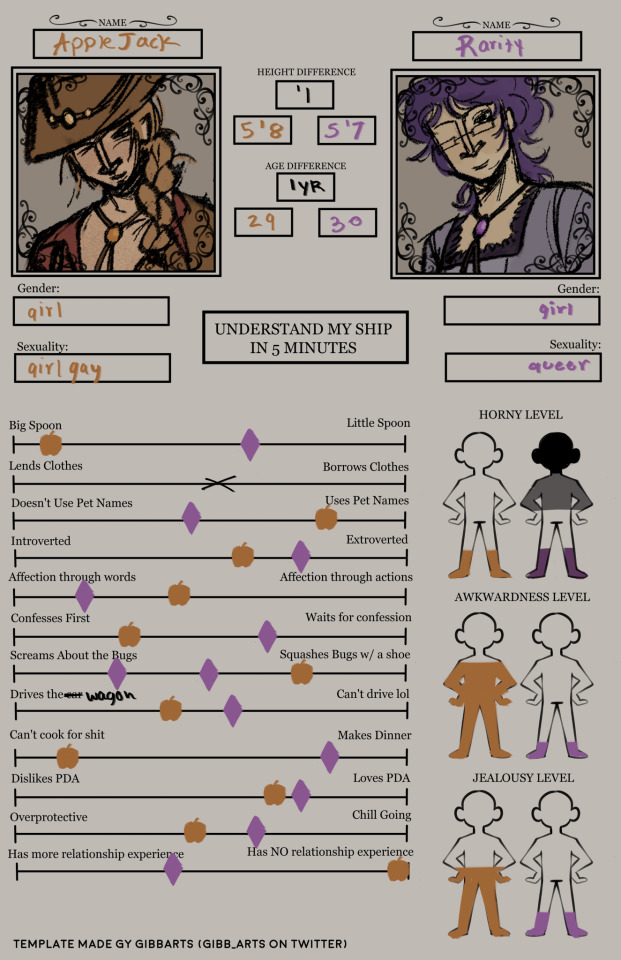

flutterdash and rarijack ship template things❤️❤️❤️❤️🎀🎀🎀🎀🎀🎀🎀🎀🏳️🌈 (twipie is soon to come) (ignore how i wrote that rd is 2 years old) (i forgot to write the second number)
#mlp#my little pony g3#my little pony#wild west au#cowboy au#mlp x rdr#red dead redemption#rdr1#rdr2#flutterdash#rarijack#twipie
114 notes
·
View notes
Text
BOSSGAME is here!
BOSSGAME: The Final Boss is My Heart is now ready for you to play on PC and Mac!!
😈 Team up with your girlfriend to hunt devils and pay the rent!
💜 Flirt with friends and enemies!
⚔️ Fight your corrupt employer!
🎵 Some of the best boss-fighting tunes you've ever heard
✨ you will cry
Finally, check out the critically-acclaimed lesbian romance boss rush, now on the big screen (your computer)!!
Bossgame is available now on Steam and Itch! On sale, even!!
310 notes
·
View notes
Text

lesbians love a big mac actually
this was a patreon request for @doggirlhen :)
351 notes
·
View notes
Note
Muffin! It's ASP Inc, the conglomerate made up of the companies formerly known as Apple, Sony, and Pepsi-Co. Based on your credentials with prior projects, you've been conscripted again for another big budget Twilight media project! Probably the CEO is on drugs, but congrats on your $500m dollar budget.
Your task is to design a big-budget Twilight video game. "But I don't really play that many video games," you maybe say? Idk, the CEO doesn't seem to care and is maybe using this project for tax evasion, so your instructions are "Just make us a Twilight game with gameplay stolen from a popular thing like a Minecraft, Fortnight, Among Us, whatever the kids nowadays are playing. Maybe a Mario? Are Marios still a thing?? I played Oregon Trail on my mac once. Stick some story in it. Give it the Muffin treatment, kids like Muffins!"
Your project brief must include:
1) What non-story-based gameplay mechanic you're stealing ("It's like a Mario!")
2) What story set in the Twilight Universe (tm) you've decided is most game-able.
3) Where you're spending the big bucks.
Thank you and good luck! (I hope this is fun and not, you know, annoying)
That would be a very silly thing for them to do.
Caveat
Twilight already is a video game: it's a visual novel. You are Bella Swan, first person point of view, checking out hottie mchottie across the hall. You don't know it, but the wrong action you take, even if it's arriving in the parking lot late: you die.
It's up to you to find Bella's golden path to survival which is in fact the Twilight novels we know and love.
Ordinarily, I'm a big skeptic of medium jumps without much thought, especially to and from video games as they usually don't transition well. However, in this case, we're already there.
You don't even have to change that much of the narrative structure since it's all in first person and we have the visuals as we know exactly what everyone looks like down to what exact shade of red their hair is.
There's not much for me to do.
But That Will Never Fly/Isn't What You Asked For
It sounds like this merger corporation doesn't really understand Twilight or video games which is not surprising. So, I have to make a real person video game which is just like that thing the kiddos are playing.
And since I'm going to hell anyway: I'm making a Twilight game that's RDR/GTA styled and we're going wild.
You're Bella Swan going to high school but you can wander around the town of Forks/the world at large and do whatever the fuck you want. This often gets you killed horribly. You go to Mexico: you're eaten by vampires. You go to Alaska: you get fucked by vampires and have a wild time in their sauna. You go to Egypt: some guy named Amun locks you in a tomb where you hang out with Benjamin, Tia, and Amun's angry wife. You can take missions for the Volturi, which they never asked you to do, and every time you collect a bounty a Volturi member will give you a weird look and ask "what the fuck is wrong with you/why are you here?" but you'll earn in game rewards as they publicly shame you.
You can also get into affairs with your human friends and ruin Jessica's love life, go to Prom with five people, and so on and so forth.
You can also get involved in the La Push community where they stare at you for being this person who clearly doesn't belong and try to seduce Leah into a lesbian love affair with you. (This is a very difficult quest, Leah's not impressed and very confused and going through it with Sam right now). You get to hear all of people's drama that's going on in the side lines.
The actual plot is dating Edward, and somehow, he doesn't notice all your wild adventures because he can't read your mind and while he's been stalking you every time you leave the state he loses your scent.
Your missions are surprisingly difficult as you have to avoid death by Edward by saying the right things and avoid death by everything else in the universe by navigating Port Angeles correctly (shockingly hard as the rapists somehow corner you at every turn). You also get missions during the Hallucination Edward arc as you have to do increasingly difficult and dangerous things to get Hallucination Edward to appear at which point your player character gets sweet sweet endorphins.
In the online player mode, where you've probably become a vampire, you can engage in vampire warfare where the losing condition is you killed too many humans so the Volturi come to kill all of you.
And yes, of course, there is an honor system but you blow it yourself as Bella's honor plummets during New Moon when she has to endanger herself and others to see Edward.
The money's going into a) graphics b) the sheer open worldness allowed in the number of quests, the random events, and all that good points.
Conclusion
I imagine they ask me how I will market this game to Twilight's audience, who are presumably the only ones who will play this game, and I claim, "Young women love grand theft auto!"
82 notes
·
View notes
Text
Genderbend IASIP headcanons/generalizations
Mac is butch but is very insecure about her masculinity and didn’t like being perceived as a lesbian so she did try to perform femininity but was super uncomfortable during it
Charlie was dropped off in a basket on Man!Bonnies doorstep by her mom
Franny knew right away that Denise and Dee weren’t hers but was still pissed that the mother was Fem!Bruce
Charlie, Mac and Denise tried out for the cheerleading team in high school, but only Denise got in, Mac broke her pelvis trying to do splits and Charlie couldn’t follow directions, even then she didn’t last long
Mac’s full name is Ronette McDonald, Dee’s is Dedrick Reynolds, and Charlie’s is Charlotte Rosalinde Kelly
Dee frequently crossdresses for his characters, like in over the top drag queen fashion, he wants to go on RuPaul
Cricket is a prostitute with a bad pimp
Mac, Charlie and Denise have all gotten pregnant at one point
Mr. Mac is an alcoholic instead of a smokes
Charlie smells down there
Everyone has raging mommy issues
Maurice Ponderosa is a dog man
Dee is still as misogynist as ever
Denise has big honkers
Mac enjoys action movies with hot chicks and boobs
“Flashing Tits” = Hang dong
#thad says something#iasip#its always sunny in philadelphia#genderbent sunny#charlie kelly#dennis reynolds#mac mcdonald#dee reynolds#frank reynolds
65 notes
·
View notes